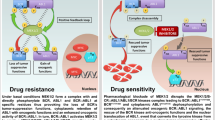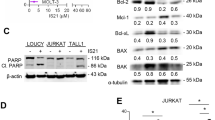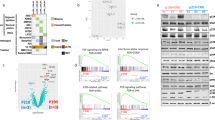Abstract
In Philadelphia chromosome-positive (Ph+) leukemia BCR/ABL induces the leukemic phenotype. Targeted inhibition of BCR/ABL by kinase inhibitors leads to complete remission. However, patients with advanced Ph+ leukemia relapse and acquire resistance, mainly due to point mutations in BCR/ABL. The ‘gatekeeper mutation’ T315I is responsible for a general resistance to small molecules. It seems not only to decrease the affinity for kinase inhibitors, but to also confer additional features to the leukemogenic potential of BCR/ABL. To determine the role of T315I in resistance to the inhibition of oligomerization and in the leukemogenic potential of BCR/ABL, we investigated its influence on loss-of-function mutants with regard to the capacity to mediate factor independence. Here, we show that T315I (i) requires autophosphorylation at tyrosine 177 in the BCR-portion to mediate resistance against the inhibition of oligomerization; (ii) restores the capacity to mediate factor-independent growth of loss-of-function mutants due to an increase in or activation of ABL-kinase; (iii) leads to phosphorylation of endogenous BCR, suggesting aberrant substrate activation by BCR/ABL harboring the T315I mutation. These data show that T315I confers additional leukemogenic activity to BCR/ABL, which might explain the clinical behavior of patients with BCR/ABL–T315I-positive blasts.
This is a preview of subscription content, access via your institution
Access options
Subscribe to this journal
Receive 12 print issues and online access
$259.00 per year
only $21.58 per issue
Buy this article
- Purchase on Springer Link
- Instant access to full article PDF
Prices may be subject to local taxes which are calculated during checkout





Similar content being viewed by others
References
Faderl S, Talpaz M, Estrov Z, O'Brien S, Kurzrock R, Kantarjian HM . The biology of chronic myeloid leukemia. N Engl J Med 1999; 341: 164–172.
Lugo TG, Pendergast AM, Muller AJ, Witte ON . Tyrosine kinase activity and transformation potency of bcr-abl oncogene products. Science 1990; 247: 1079–1082.
Deininger MW, Goldman JM, Lydon N, Melo JV . The tyrosine kinase inhibitor CGP57148B selectively inhibits the growth of BCR-ABL-positive cells. Blood 1997; 90: 3691–3698.
Druker BJ, Tamura S, Buchdunger E, Ohno S, Segal GM, Fanning S et al. Effects of a selective inhibitor of the Abl tyrosine kinase on the growth of Bcr-Abl positive cells. Nat Med 1996; 2: 561–566.
Weisberg E, Griffin JD . Mechanism of resistance to the ABL tyrosine kinase inhibitor STI571 in BCR/ABL-transformed hematopoietic cell lines. Blood 2000; 95: 3498–3505.
Ramirez P, DiPersio JF . Therapy options in imatinib failures. Oncologist 2008; 13: 424–434.
Cowan-Jacob SW, Guez V, Fendrich G, Griffin JD, Fabbro D, Furet P et al. Imatinib (STI571) resistance in chronic myelogenous leukemia: molecular basis of the underlying mechanisms and potential strategies for treatment. Mini Rev Med Chem 2004; 4: 285–299.
Deininger M . Resistance to imatinib: mechanisms and management. J Natl Compr Canc Netw 2005; 3: 757–768.
Shah NP, Nicoll JM, Nagar B, Gorre ME, Paquette RL, Kuriyan J et al. Multiple BCR-ABL kinase domain mutations confer polyclonal resistance to the tyrosine kinase inhibitor imatinib (STI571) in chronic phase and blast crisis chronic myeloid leukemia. Cancer Cell 2002; 2: 117–125.
Druker BJ . Translation of the Philadelphia chromosome into therapy for CML. Blood 2008; 112: 4808–4817.
Beissert T, Puccetti E, Bianchini A, Güller S, Boehrer S, Hoelzer D et al. Targeting of the N-terminal coiled coil oligomerization interface of BCR interferes with the transformation potential of BCR-ABL and increases sensitivity to STI571. Blood 2003; 102: 2985–2993.
Beissert T, Hundertmark A, Kaburova V, Travaglini L, Mian AA, Nervi C et al. Targeting of the N-terminal coiled coil oligomerization interface by a helix-2 peptide inhibits unmutated and imatinib-resistant BCR/ABL. Int J Cancer 2008; 122: 2744–2752.
Puccetti E, Güller S, Orleth A, Brüggenolte N, Hoelzer D, Ottmann OG et al. BCR-ABL mediates arsenic trioxide-induced apoptosis independently of its aberrant kinase activity. Cancer Res 2000; 60: 3409–3413.
Griswold IJ, MacPartlin M, Bumm T, Goss VL, O'Hare T, Lee KA et al. Kinase domain mutants of Bcr-Abl exhibit altered transformation potency, kinase activity, and substrate utilization, irrespective of sensitivity to imatinib. Mol Cell Biol 2006; 26: 6082–6093.
Zheng X, Beissert T, Kukoc-Zivojnov N, Puccetti E, Altschmied J, Strolz C et al. Gamma-catenin contributes to leukemogenesis induced by AML-associated translocation products by increasing the self-renewal of very primitive progenitor cells. Blood 2004; 103: 3535–3543.
Barilá D, Superti-Furga G . An intramolecular SH3-domain interaction regulates c-Abl activity. Nat Genet 1998; 18: 280–282.
Franz WM, Berger P, Wang JY . Deletion of an N-terminal regulatory domain of the c-abl tyrosine kinase activates its oncogenic potential. EMBO J 1989; 8: 137–147.
Laurent E, Talpaz M, Kantarjian H, Kurzrock R . The BCR gene and philadelphia chromosome-positive leukemogenesis. Cancer Res 2001; 61: 2343–2355.
Azam M, Seeliger MA, Gray NS, Kuriyan J, Daley GQ . Activation of tyrosine kinases by mutation of the gatekeeper threonine. Nat Struct Mol Biol 2008; 15: 1109–1118.
Acknowledgements
This project was supported by a grant from Deutsche Forschungsgemeinschaft (DFG-RU 728/3-1) to MR. MR is further funded by grants from Alfred und Angelika Gutermuth Foundation, Deutsche Krebshilfe e.V. (DKH-107063 and DKH-107741) and Deutsche José Carreras Leukämie-Stiftung e.V. (DJCLS - R 07/27f).
Author information
Authors and Affiliations
Corresponding authors
Additional information
Supplementary Information accompanies the paper on the Leukemia website (http://www.nature.com/leu)
Supplementary information
Rights and permissions
About this article
Cite this article
Mian, A., Schüll, M., Zhao, Z. et al. The gatekeeper mutation T315I confers resistance against small molecules by increasing or restoring the ABL-kinase activity accompanied by aberrant transphosphorylation of endogenous BCR, even in loss-of-function mutants of BCR/ABL. Leukemia 23, 1614–1621 (2009). https://doi.org/10.1038/leu.2009.69
Received:
Revised:
Accepted:
Published:
Issue Date:
DOI: https://doi.org/10.1038/leu.2009.69
Keywords
This article is cited by
-
Cabozantinib promotes erythroid differentiation in K562 erythroleukemia cells through global changes in gene expression and JNK activation
Cancer Gene Therapy (2022)
-
AXL receptor tyrosine kinase: a possible therapeutic target in acute promyelocytic leukemia
BMC Cancer (2021)
-
Crizotinib acts as ABL1 inhibitor combining ATP-binding with allosteric inhibition and is active against native BCR-ABL1 and its resistance and compound mutants BCR-ABL1T315I and BCR-ABL1T315I-E255K
Annals of Hematology (2021)
-
Efficacy and safety of ponatinib for patients with Philadelphia chromosome-positive acute lymphoblastic leukemia: a case series from a single institute
International Journal of Hematology (2021)
-
Allosteric inhibition enhances the efficacy of ABL kinase inhibitors to target unmutated BCR-ABL and BCR-ABL-T315I
BMC Cancer (2012)



